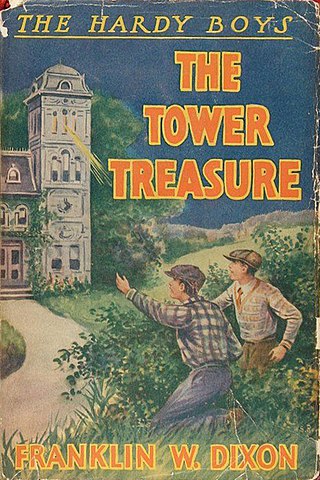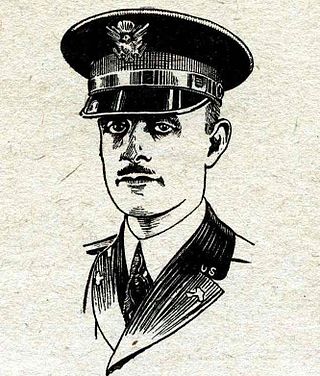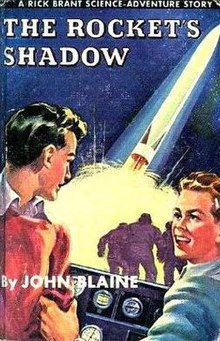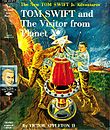
Tom Swift Jr. is the central character in a series of 33 science fiction adventure novels for male adolescents, following in the tradition of the earlier Tom Swift ("Senior") novels. The series was titled The New Tom Swift Jr. Adventures. Unlike the Nancy Drew and Hardy Boys titles that were also products of the prolific Stratemeyer Syndicate, the original Tom Swift stories were not rewritten in the 1950s to modernize them. It was decided that the protagonist of the new series would be the son of the earlier Tom Swift and his wife, Mary Nestor Swift; the original hero continued as a series regular, as did his pal Ned Newton. The covers were created by illustrator J. Graham Kaye. Covers in the later half of the series were mostly by Charles Brey. A total of 33 volumes were eventually published.

The Hardy Boys, brothers Frank and Joe Hardy, are fictional characters who appear in a series of mystery novels for young readers. The series revolves around teenage amateur sleuths, solving cases that often stumped their adult counterparts. The characters were created by American writer Edward Stratemeyer, the founder of book packaging firm Stratemeyer Syndicate. The books were written by several ghostwriters, most notably Leslie McFarlane, under the collective pseudonym Franklin W. Dixon.

Howard Roger Garis was an American author, best known for a series of books that featured the character of Uncle Wiggily Longears, an engaging elderly rabbit. Many of his books were illustrated by Lansing Campbell. Garis and his wife, Lilian Garis, were possibly the most prolific children's authors of the early 20th century.
John Peel is a British writer, best known for his TV series tie-in novels and novelisations. He has written under several pseudonyms, including "John Vincent" and "Nicholas Adams". He lives on Long Island, New York. While his wife is a US citizen, Peel continues to travel under a British passport.

The Rover Boys, or The Rover Boys Series for Young Americans, was a popular juvenile series written by Arthur M. Winfield, a pseudonym for Edward Stratemeyer. Thirty titles were published between 1899 and 1926 and the books remained in print for years afterward.
Joseph Lawrence Greene was an American author of science fiction novels and short stories whose most familiar creations are Tom Corbett, Space Cadet which, in 1951, became a television series popular with young audiences, as well as Dig Allen Space Explorer, a series of six books published between 1959 and 1962, which focused around the adolescent hero Dig Allen and his interplanetary adventures in the genre of boys' juvenile literature. A prolific writer, he also contributed numerous stories to comic books and was an editor, until 1972, for Grosset publishing while writing under a number of pseudonyms including, purportedly, the house pen name "Alvin Schwartz" and also "Richard Mark", and using sundry variations of his own name, which exemplified such foreign-language wordplays for "Green" as "Verdy", "Verdi" and "Vert".
Tom Swift III is the unofficial name of this series of juvenile science fiction adventure novels, the third to feature a protagonist named Tom Swift. Unlike the previous series, it was not published by the Grosset & Dunlap, but was published by Wanderer Books, a division of Simon & Schuster, which, at the tail-end of the series bought and obtained the rights of the Stratemeyer Syndicate's series. However, all gave the author as Victor Appleton, as with the previous series.

Tom Quest is the central character in a series of eight adventure novels for adolescent boys written by Lone Ranger series author Fran Striker. The first six novels were published by Grosset & Dunlap between 1947 and 1952. The series was later reprinted by Clover Books, when #7-8 were published. The six Grosset & Dunlap titles were issued in dust jacket; the Clover Books reprints and their two original titles have picture covers and no dust jackets. The plot of volume #8 was lifted from Striker's Gene Autry and the Redwood Pirates.
Grosset & Dunlap is a New York City-based publishing house founded in 1898.

The Secret of Wildcat Swamp is Volume 31 in the original The Hardy Boys Mystery Stories published by Grosset & Dunlap.

The Firebird Rocket is Volume 57 in the Hardy Boys series of mystery books for children and teens published by Grosset & Dunlap. The book was written for the Stratemeyer Syndicate by Vincent Buranelli in 1978.
Harold Leland Goodwin was an American writer.
Bernard Alvin Palmer (1914–1998), born in Central City, Nebraska, United States, was the originator and author of over 165 books for Christian youth, as well as several books for adults. He created series such as the Danny Orlis series, the Felicia Cartright series, and the Pioneer Girls series, which he co-authored with his wife Marjorie Palmer.

Bomba the Jungle Boy is a series of American boys' adventure books produced by the Stratemeyer Syndicate under the pseudonym Roy Rockwood. and published by Cupples and Leon in the first half of the 20th century, in imitation of the successful Tarzan series.

Biff Brewster is the central character in a series of 13 adventure and mystery novels for adolescent boys written by Andy Adams. The series was published by Grosset & Dunlap between 1960 and 1965.

Jeff Belanger is an American writer who focuses on the paranormal. He hosts the Emmy-nominated series New England Legends and co-hosts, with Ray Auger, the New England Legends podcast. He is a writer and researcher for Ghost Adventures and has appeared on several episodes. Paranormal researcher Ben Radford calls Belanger a "ghost storyteller" rather than a "ghost investigator." In 2021, Belanger published a book about his experience reaching the summit of Mount Kilimanjaro in Africa.

Inez Haynes Irwin was an American feminist author, journalist, member of the National Women's Party, and president of the Authors Guild. Many of her works were published under her former name Inez Haynes Gillmore. She wrote over 40 books and was active in the suffragist movement in the early 1900s. Irwin was a "rebellious and daring woman", but referred to herself as "the most timid of created beings". She died at the age of 97.
The Honey Bunch series of books were part of the Stratemeyer Syndicate's production of 20th century children's books featuring adventurous youngsters, which included the series Nancy Drew, the Hardy Boys and the Bobbsey Twins. This series was written under the pseudonym Helen Louise Thorndyke, and published for most of its duration by Grosset & Dunlap. The series began in 1923 and chronicled a young girl named Honey Bunch on her various trips and adventures. Along with Laura Lee Hope's series Bunny Brown and His Sister Sue, it was one of their most famous series for younger children.

Sterner St. Paul Meek was an American military chemist, early science fiction author, and children's author. He published much of his work first as Capt. S.P. Meek, then, briefly, as Major S.P. Meek and, after 1933, as Col. S. P. Meek. He also published one story as Sterner St. Paul.













